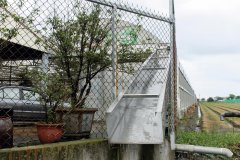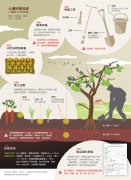What does agricultural catastrophe insurance cover? The necessity of constructing Agricultural Occupational disaster guarantee
Farmers themselves lack awareness of occupational safety, lack of occupational disaster insurance claims, fear that the crops will not be harvested in time, and continue to engage in farming with illness and pain. Compared with other industries, is the risk of agriculture high? Is there a legal source to ensure the occupational safety of farmers? Let's take a look at it.
Data Source / preliminary study on Occupational Safety and Health of Middle-aged and elderly Workers, Li Yusheng and Xu Xianhui, 2008.

Farmers are aging and have no concept of occupational safety, which increases the risk of occupational disasters.
Although Taiwan does not have special data on the risk of agricultural occupational disasters, we can consider whether agriculture is a high-risk industry from the "Summary Analysis of the preliminary Statistical results of the 2015 General Survey of Agriculture, Forestry, Fisheries and Animal Husbandry" of the Office of Comptroller, Accounting and Statistics of the Executive Yuan.
The report of the Comptroller, Accounting and Statistics Office shows that the average age of agricultural managers is 63.2 years old, which tends to be older. The statistics of employees in agriculture, forestry, fishery and animal husbandry are also included in the preliminary study on Occupational Safety and Health of Middle-aged and elderly Workers by the Institute of Labor and Occupational Safety and Health of the Ministry of Labor. It is worth noting that among the 20 industries, the proportion of employees over the age of 61 in agriculture, forestry, fisheries and animal husbandry is the highest.
Statistics show that the rates of "no regular health check-up" and "no occupational safety education" among agriculture, forestry, fishery and animal husbandry practitioners are generally the highest, and the proportion of injuries or diseases among employees in agriculture, forestry, fishery and animal husbandry is also high, with an average of about 28% in the past year.
From the research, we can see that the risks of farmers have always existed, except that some agricultural employees form professional trade unions to apply for labor insurance and enjoy occupational disaster protection, under the circumstances that the existing peasant insurance does not have the ability to settle claims for occupational disasters, coupled with the fact that farmers are not workers, in the event of occupational disasters, they are unable to enjoy the protection of social insurance.
However, agriculture itself is a "profession", and farmers' work also belongs to labor behavior. Bringing farmers' occupational disasters into the management of "Occupational Safety and Health Law" and cooperating with the future "Occupational disaster Insurance Law" (referred to as "Occupational disaster Law") is one of the ways to solve the existing farmers' lack of occupational disaster insurance protection.
There is a shortage of agricultural manpower, and during the busy period of agriculture, there are only the elderly in rural areas.
To promote the separate legislation of the Occupational disaster Law, the object of protection should also be included in farmers.
The Occupational Safety and Health Law, formerly known as the Labor Safety and Health Law, is mainly formulated to prevent occupational disasters and protect the safety and health of workers. In the past, the scope of application of this law was limited. According to the study of "Review and Prospect of the scope of Application of the Occupational Safety and Health Law", the total number of workers in 2012 was 8.18 million 6000, of which only 5.41 million 2000 were eligible for the law, representing only 66 per cent of the total number of workers.

Based on the principle of equal rights for labor and the principle of equality in Taiwan's Constitution, this law has been amended for the fourth time on June 18, 2013, changing its scope to "applicable to all industries", that is, including "agriculture, forestry, fishing and animal husbandry". And came into force on July 3, 2014.
Article 2 of the Occupational Safety and Health Law also states that the workers protected, refers to workers, self-employed workers and other persons directed or supervised by the person in charge of the workplace. Article 2 of the rules for the implementation of the Occupational Safety Law also states in detail that self-employed workers are independently engaged in labor or technical work, are paid, and do not employ paid personnel to help the same workers.
However, for self-employed workers such as farmers, they usually lack the concept of attaching importance to safety and health in the workplace. after bringing them into the management of laws and regulations, the government also needs to strengthen occupational safety and health education and education to guide their workplaces to conform to standards. improve the working environment.
According to the 2016 Annual report on Labor Statistics, the number of people employed in agriculture, forestry, fishing and animal husbandry in Taiwan dropped from 24.92 percent in 1978 to 4.95 percent in 2015. Food is the most important thing for the people, and the shortage of agricultural manpower is not only due to the decline of old farmers. if we want to attract more young people, how to build a friendly agricultural professional working environment and occupational safety through the mechanism of counselling, education and training? is the basis for sustainable agricultural development.
- Prev

How to build a greenhouse? What are the methods and benefits of building a vegetable greenhouse?
According to the sharing of experts' experience, the common Liba greenhouse and intelligent flower facilities with science and technology and enterprise scale are introduced respectively, reminding farmers how to assess their needs, profits and other key points to create an ideal greenhouse suitable for them. In order to
- Next

Soil fertility testing: how to rationalize fertilization? Analysis report on soil Fertility Grade
The promotion of rational fertilization can avoid excessive application of fertilizer and is beneficial to the sustainable use of farmland. Rational fertilization refers to farmers according to the growth characteristics of crop varieties, matching soil conditions and characteristics, types and characteristics of fertilizers, and cropping after application to the soil.
Related
- A one-day flower show brings 130 million yuan in orders! Nanhai, this Phalaenopsis exhibition is amazing
- What do the flower language and meaning of Lutheran tree mean? Precautions for planting Lutheran tree
- Encounter Chaoshan Kongfu tea, not without this cup of Phoenix single clump
- The durian market in Vietnam and Thailand is flooded. The price of imported durian has plummeted by 30-40% in a month.
- Shanghai solved the problem of local vegetable supply by planting 80,000 mu of green leafy vegetables.
- Wageningen University has become the best agricultural university in the world for the seventh time in a row.
- The strongest export season of South African grapes is full of challenges, with exports to Russia falling sharply by 21%.
- Sri Lanka is on the verge of bankruptcy, "Tea for debt" Organic Agriculture Revolution aggravates the Food crisis?
- Turning waste into earthworm manure and worm manure into organic fertilizer-A new choice for auxiliary farming
- Organic rice growers shoulder the responsibility of nurturing agricultural talents! Yinchuan Sustainable Farm with Organic Life Camp

